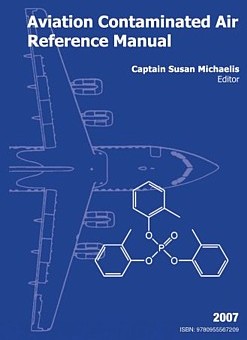
THE AIRLINE PILOTS FORUM & RESOURCE
Contaminated Air in Aircraft |
| Source: www.SusanMichaelis.com |
 |
Aviation Contaminated Air Reference Manual by Captain Susan Michaelis
|
Captain Susan Michaelis, the author of Aviation Contaminated Air Reference Manual grew up in Melbourne, Australia. She commenced flying in 1986 and was the 1987 winner of the Australian Civil Aviation Authority Sir Donald Anderson Trophy for Academic Merit. She has flown over 5,000 hours as an airline pilot but due to ill health retired after flying the British Aerospace BAe 146 for three years in 1997. She helped set up the Australian Senate Investigation into the cabin air quality issues on the BAe 146 (1999-2000) and published many papers on this issue. Currently she is undertaking a PhD focusing on the contaminated air issue at the University of New South Wales (UNSW) in Sydney. Susan is presently a consultant on the contaminated air issue and the researcher for the Global Cabin Air Quality Executive (GCAQE). Aviation Contaminated Air Reference Manual [ISBN: 9780955567209] is an 844 page reference manual, which is the result of nearly ten years of research, is aimed at policy makers, doctors, scientists, air accident investigators, engineers, crews, passengers, airline and union representatives, politicians and media involved or interested in any aspect of the contaminated air debate on commercial and military aircraft. |

|
Reviews of Aviation Contaminated Air Reference Manual
Dr Bhupi Singh
Assoc. Prof. and Head of Research
RAAF Institute of Aviation Medicine,
RAAF Base Edinburgh SA, 5111, Australia
The Aviation Contaminated Air Reference Manual, by Captain Susan Michaelis, is the first-ever comprehensive and definitive attempt to document and encapsulate the problem of aircraft cabin air quality in one book. The problem of cabin air quality is complex, under-reported, and poorly understood. A significant part of the problem is a lack of authentic and published data. Hopefully this manual will fill at least a part of that lacuna.
The Manual is organised into 29 chapters, and 12 appendices. The overall arrangement and organisation of the material may appear a bit overwhelming at first, but this could perhaps be attributed to the sheer volume of data that has been collected and presented. However the data is methodically set out in clearly labelled sections and is an important resource for those wanting to understand the particular issues involved with aircraft contaminated air.
The manual starts by explaining the basics of the problem, followed by extensive documentation of events where aircrew or passengers were exposed to, and/or affected by, toxic fumes inside an aircraft cockpit or cabin. The “events” data pertains to a wide range of aircraft operators in many countries spread across the globe. All data is extensively researched and referenced, with its source clearly identified. In fact one of the strengths of the Manual is its extensive referencing.
The Manual should be of interest to professionals dealing with the problem of health and well-being of not only the pilots and cabin attendants, but that of the travelling public at large. Occupational health professional, aircraft designers, and the regulators of civil and military aviation would find the contents informative, and perhaps help the aviation community address the problem, which goes well beyond being “just a nuisance” to causing genetic damage and leading to significant and long lasting neurological damage in some cases.
A notable and distressing element of the data is the widespread prevalence of denial of the existence of the problem, particularly among the aircraft operators and aviation regulators. In keeping with the advances made by the humanity in improving and maintaining the health and well being of people in their work places, and of the general public during their interaction with technology, it is not unreasonable to expect responsible professionals in all walks of life to have at least an open mind when presented with a “new” problem. It is hoped that this manual will spur an objective and closer look at the issues involved. This Manual should make any reader sit up and ponder, and perhaps neutralise some of the scepticism prevailing among some sections of society about the reality of this problem.
The manual is obviously a labour of love, and the dedication of the author is quite apparent, who needs to be commended for her ground-breaking and seminal work.
David Evans
Editor of Air Accident Digest
www.airaccidentdigest.com
Over recent years, there have been reports of pilots, flight attendants and passengers evacuated to hospitals after breathing contaminated air in the airplane. A typical investigation, such as this one involving a B757, reads, 'After engine start, the crew were aware of an unusual odor in the cockpit and both started to feel unwell. Investigation suggested that a suspected oil leakage in the left engine may have been responsible for the smell.'
Oftentimes, it's more than a bad smell; it's debilitating. This excellent book outlines why the air in the cockpit or cabin becomes contaminated, with what the air was fouled, and what can be done about it."
Captain Colin Barnet - Higgins
A reference manual that clearly demonstrates contaminated air is serious flight safety and health issue. Most pilots and aviation employees lack the knowledge and facts needed to understand the serious threat contaminated air can be. This reference manual is a must read for anyone employed in aviation.
Melissa Dray
Former Flight Attendant
Finally a summary of a 40 year problem in one reference manual. A problem which took away my dream job due to its serious health impacts. If you fly, this is a book you should read.
Dick Best
Former CASA Airwothiness Officer
An internationally accepted definition of aircraft airworthiness is compliance with all the applicable legal requirements / regulations. These requirements include the appropriate “Design Standards” applicable to the particular aircraft.
Non compliance with these requirements render an aircraft unairworthy.The facts presented in this book demonstrate the requirements, applicable to clean air in a number of identified aircraft types, are not being met which cause the aircraft to be a danger to person and property. Such non-conformance requires urgent review.
Dr Andrew Harper
Occupational and Public Health Physician
MBBS (Syd), MPH (Harv), DrPH (Harv), FAFOM, FAFPHM.
Contaminated air is a serious occupational and public health issue which could be easily addressed if there was a collective will to do so. This reference manual clearly shows there is enough evidence to warrant action.
The Air Reference Manual Chapters and Appendices
Chapters:
Understanding the Problem.
What is in Contaminated Air.
The Toxicology Debate.
The Mislabelling of Engine Oils.
Effects On Crews and Passengers - Symptoms Seen and Reported.
Medical Side - Doctors and Scientists.
The Kolvar and other Australian Incidents - The Findings of the Australian ATSB.
The Malmo BAe 146 Incident of 12 November 1999 and a Swedish Perspective.
UK AAIB Report into the BAe 146 G-JEAK Incident of 05 November 2000.
UK AAIB Report into the Boeing 757 G-CPER Incident of 07 September 2003.
Frequency of Events and Under Reporting.
ASHRAE.
The ITF and the International Task Group on Aircraft Air Quality
Regulations to Protect Us.
The Exposure Standard Debate.
What They Knew and What They Did: a BAe 146 Analysis.
18. The Inquiries.
The Public Conferences Including the 2005 BALPA Conference.
The UK Civil Aviation Authority Report - Cabin Air Quality 2004.
US Perspective.
The Airline Industry Misinformation Campaign.
Occupational Health Research Consortium in Aviation (OHRCA) Project.
SAE.
UK Committee On Toxicity (COT)
Filtration.
Canadian Perspective..
Important Dates in the Chronology of the Contaminated Air Debate.
Solutions and the Future.
Appendices:
A01: Typical Aircraft Air System.
A02: Incidents on the UK database as of 1 August 2006.
A03: Chemicals reported found in aircraft cabins and cockpits.
A04: MSDS extracts data of chemicals found in commercial aircraft.
A05: BAe 146 Service Bulletins, Service Information Leaflets and Data confirming CAQ problem.
A06: BAe 146 Contaminated air events given to the Australian Senate by the FAAA.
A07: USA Contaminated air events as of 18 August 1997 listed in a NIOSH HHE application.
A08: AOPIS COT Committee report 'AOPISCOT024' dated 3 July 2006.
A09: ASRS data: 'Smoke/fire/odor related incidents involving ATR 42, B757 & BAe 146 aircraft.'
A10: Air monitoring research summary.
A11: AOPIS COT Committee report 'AOPISCOT025' dated 26 February 2007.
A12: AOPIS response to COT - TOX 2006/39 and TOX 2007/10 dated 16 March 2007.
The Air Reference Manual Now Available to Purchase
Visit www.SusanMichaelis.com to purchase the Aviation Contaminated Air Reference Manual online.
